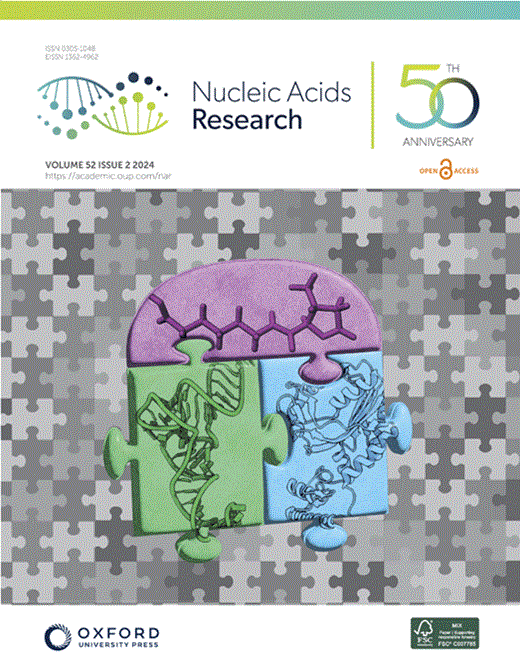RNA-binding protein Ars2 mediates transcriptional silencing of telomeric repeats and transposable elements in the Drosophila germline
IF 13.1
2区 生物学
Q1 BIOCHEMISTRY & MOLECULAR BIOLOGY
引用次数: 0
Abstract
Telomeres ensure genome stability and the levels of telomeric RNA reflect the integrity of telomeric chromatin. The highly conserved RNA-binding protein Ars2 (Arsenite-resistance protein 2) plays an essential role in the RNA nuclear metabolism and negatively regulates the expression of telomeric transcripts in human cells and in Drosophila. We found that germline knockdown of Drosophila Ars2 does not affect small RNA abundance but causes overexpression of telomeric repeats and transposable elements (TEs), accompanied by chromatin decompaction of these regions. The expression of a transgene containing the HeT-A telomeric retrotransposon was also affected by Ars2 knockdown. The mutation of the G-rich region, which is prone to the formation of G-quadruplex structures, reduces the HeT-A transgene’s sensitivity to Ars2 depletion. Intriguingly, Ars2-regulated non-telomeric TEs are also enriched by G-quadruplex structures, implying their role in the Ars2 target recognition. Ars2 also prevents the formation of R-loops at telomeres, which are most likely caused by the accumulation of unreleased transcripts. Surprisingly, Ars2 is required for the expression of R1 retrotransposons, which are integrated in rRNA genes and essential for their amplification. Our findings point to a new mechanism for control of expression of telomeric repeats and TEs in the germline involving Ars2.rna结合蛋白Ars2介导果蝇种系中端粒重复序列和转座因子的转录沉默
端粒保证了基因组的稳定性,端粒RNA的水平反映了端粒染色质的完整性。高度保守的RNA结合蛋白Ars2(亚砷酸盐抗性蛋白2)在RNA核代谢中起重要作用,负调控人类细胞和果蝇端粒转录物的表达。我们发现,果蝇Ars2基因的种系敲低并不影响小RNA丰度,但会导致端粒重复序列和转座因子(te)的过度表达,并伴随这些区域的染色质分解。含有HeT-A端粒反转录转座子的转基因的表达也受到Ars2敲低的影响。富g区突变容易形成g -四重结构,降低了HeT-A转基因对Ars2缺失的敏感性。有趣的是,Ars2调控的非端粒te也被g -四重结构富集,这表明它们在Ars2靶标识别中起作用。Ars2还阻止端粒上r环的形成,这很可能是由未释放转录本的积累引起的。令人惊讶的是,Ars2是R1逆转录转座子表达所必需的,R1逆转录转座子整合在rRNA基因中,对其扩增至关重要。我们的研究结果指出了一种新的机制来控制端粒重复序列和TEs在生殖系中的表达,涉及Ars2。
本文章由计算机程序翻译,如有差异,请以英文原文为准。
求助全文
约1分钟内获得全文
求助全文
来源期刊

Nucleic Acids Research
生物-生化与分子生物学
CiteScore
27.10
自引率
4.70%
发文量
1057
审稿时长
2 months
期刊介绍:
Nucleic Acids Research (NAR) is a scientific journal that publishes research on various aspects of nucleic acids and proteins involved in nucleic acid metabolism and interactions. It covers areas such as chemistry and synthetic biology, computational biology, gene regulation, chromatin and epigenetics, genome integrity, repair and replication, genomics, molecular biology, nucleic acid enzymes, RNA, and structural biology. The journal also includes a Survey and Summary section for brief reviews. Additionally, each year, the first issue is dedicated to biological databases, and an issue in July focuses on web-based software resources for the biological community. Nucleic Acids Research is indexed by several services including Abstracts on Hygiene and Communicable Diseases, Animal Breeding Abstracts, Agricultural Engineering Abstracts, Agbiotech News and Information, BIOSIS Previews, CAB Abstracts, and EMBASE.
 求助内容:
求助内容: 应助结果提醒方式:
应助结果提醒方式:


